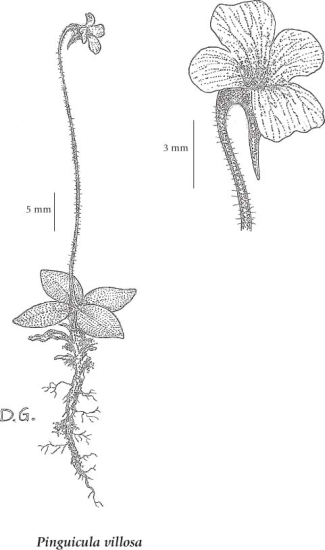hairy butterwort
Lentibulariaceae (Bladderwort family)
Introduction to Vascular Plants
Photograph
© Alfred Cook (Photo ID #8502)
Species Information
General:
Insect-eating perennial herb from a fibrous root; stems erect, simple, solitary to few, 2-12 cm tall, densely, long glandular-hairy, the hairs club-shaped.
Leaves:
Basal leaves several, simple, entire, fleshy, oblanceolate, 0.4-1.5 cm long, 2-7 mm wide, glabrous below, glabrous or slimy-glandular above (where small insects are digested), margins not rolled under; stem leaves lacking.
Flowers:
Inflorescence of single flowers; corollas funnel-like, lavender-blue, 6-10 mm long, with a spur, white hairs in the throat, the lobes of the lower lip oblong; calyces 5-lobed, 1-2 mm long.
Fruits:
Capsules, 3-5 mm long, erect.
Illustration

If more than one illustration is available for a species (e.g., separate illustrations were provided for two subspecies) then links to the separate images will be provided below. Note that individual subspecies or varietal illustrations are not always available.
Illustration Source: The Illustrated Flora of British Columbia
Ecology
The table below shows the species-specific information calculated from
original data (BEC database) provided by the BC Ministry of Forests and Range.
(Updated August, 2013)
| Site Information |
Value / Class |
||
|
Avg |
Min |
Max |
|
| Elevation
(metres) |
434 | 70 | 780 |
| Slope
Gradient (%) |
8 | 0 | 20 |
|
Aspect (degrees) |
231 | 5 | 220 |
| Soil
Moisture Regime (SMR) [0 - very xeric; 4 - mesic; 8 - hydric] |
7 | 6 | 8 |
| Modal
Nutrient Regime
Class |
A | ||
| #
of field plots species was recorded in: |
5 | ||
| Modal
BEC Zone Class |
CWH | ||
|
All BEC Zones (# of stations/zone) species was recorded in |
BWBS(2), CMA(1), CWH(2) | ||
|
Source:
Klinkenberg 2013
|
|||
Habitat and Range
Bogs and ponds (usually in Sphagnum) in the lowland and montane zones; rare in NW, NE and WC BC and on the Queen Charlotte Islands; circumboreal, N to AK, YT and NT and E to Labr.; Eurasia.Status Information
Taxonomic Keys
1. Leaves solitary or 2; scapes glandular long-hairy; corollas pale bluish-violet, less than 10 mm long..............................Pinguicula villosa
1. Leaves 5-7; scapes glabrous or obscurely glandular; corolla dark bluish-violet, more than 1.5 mm long................................Pinguicula vulgaris 2. Corola lobes of the lower lip oblong to nearly egg-shaped, more or less covering each other, or at least touching; lower lip of the calyces split up to half their length................ssp. macrocerus 2. Corolla lobes of the lower lip oblong, not covering or touching each other; lower lip of the calyces split up to 2/3 of their length.......................ssp. vulgaris |